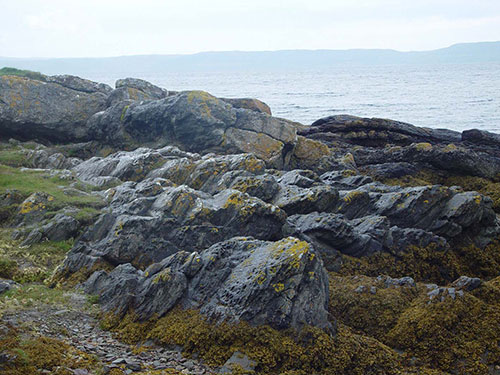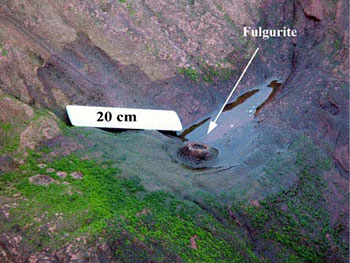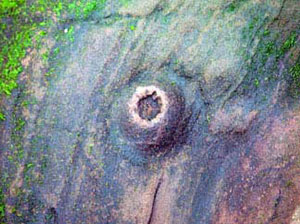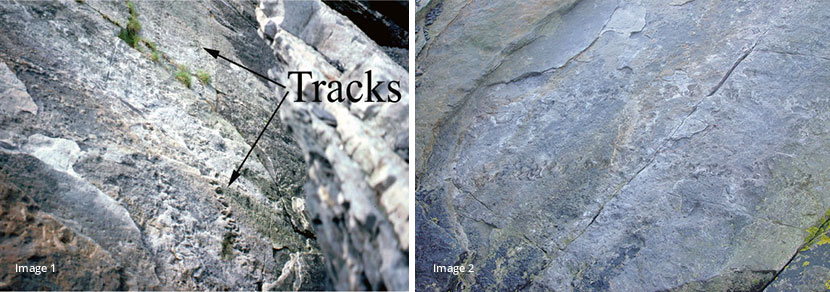We hope that you will visit Arran and come and visit the Heritage Museum, in particular the Geology Section. Better still, you may be inspired to go and visit some of the superb geological outcrops and localities on Arran. If you are unable to come to Arran we hope you will enjoy going on a virtual field trip to see some classic localities. Just select a virtual field trip from the tabs below and let’s go and look at some rocks and fossils, at least it won’t be raining.
Hutton’s Unconformity on Newton Shore
In 1787 James Hutton visited Arran and studied an outcrop on the very north east of the Island. It was to become the basis of a treatise that he wrote that was entitled the Theory of The Earth. This theory was eventually to change the way scientists thought about the processes that shaped the earth and formed rocks and was later to earn him the accolade of Father of Modern Geology. Hutton observed on the Newton Shore a calciferous sandstone bed dipping gently to the north west, the sandstone laying directly on top of steeply dipping schistose rock, the dip of the schist being approximately 45o south west. On observing the difference in the rock types, their age gap, their composition and the discordant angle of their contact, he had verified his theory.In his Theory of the Earth he envisaged an ongoing cycle of weathering and erosion of exposed rock surfaces at some points on the Earths surface and parallel mountain renewal through deep crustal processes at other points on the Earths surface. When he saw the unconformity near Lochranza he new he had found the proof of his theory. He was to later find other unconformities of a similar nature at Siccar Point and other locations. Hutton’s Theory of the Earth and Uniformitarianism first published in 1795, was not broadly accepted at the time. Other contending theories about the processes that shaped the Earth were strongly held, such as the theory that all rocks had been deposited by the biblical flood, or by a Neptunian process where all rocks were laid down in the seas.
It also has to be said, that Hutton’s Theory was not well understood by the scientific populus on the whole. However, after Hutton’s death his friend John Playfair published some drawings of the unconformity on Arran and at Siccar point and the eminent geologist Charles Lyell championed Hutton’s ideas in his publication The Principles of Geology. From then and to this day Hutton’s Theory has been widely accepted by geologists. Drawings of the Arran outcrop and cross-section made by Hutton’s friend Sir John Clerk, were included in his treatise the Theory of The Earth. Copies of these diagrams can be viewed in the Geology Section of the Heritage Museum.

1. Hutton’s Unconformity on Newton Shore, steeply dipping Dalradian schists in the foreground and Carboniferous sandstone overlying in the background.
Important fossil artefact near to Corrie Village

Situated on the coast near to Corrie Village, a sandstone hosts a very important fossil artefact. The sandstone is Permian in age and is ca. 250 million years old and was originally deposited as wind blown sand . On a outcrop a fossil lightning strike or fulgurite can be found. Fulgurite is from the Latin fulgur meaning thunderbolt, or lightning and are natural hollow carrot-shaped glass tubes. Believed to be the first reported recognition of a fossilised lightning strike in the geological and scientific literature, it was described by Harland and Hacker in 1966.

The fulgurite was formed by a bolt of lightning hitting the surface of a sand dune ca. 250 Million years ago during the Permian Period, the lightning fused the sand into a glassy material, that extends into the sand like a hollow tube. The tube was then in filled by more wind blown sand. It is estimated the loose sand was fused to make the fulgurite at approximately 1800 °C. Below we see a close up of the circular entry point, which displays a classic star shaped inner. In the Geology Section of the Heritage Museum, we have a fulgurite that was formed recently in the Sahara desert during a thunderstorm. You can compare the fossil fulgurite seen in the image below, with the recently formed fulgurite on show in the museum.
Trace Fossil on the coast between Lochranza and the mouth of the Sannox burn
Situated on the coast between Lochranza and the mouth of the Sannox burn, a Carboniferous Namurian ( ca. 320 Ma) channel sandstone hosts an extraordinary trace fossil. The trace fossil is in the form of tracks, made by a large Myriapod or Arthropleura. Discovered in 1975, by Cambridge University geologist’s, a detailed description of the tracks was made by Briggs et. al. in 1975. There are two sets of fossil tracks that can be seen on the outcrop (Images 1 and 2). The longest trail is 6.25 m long and 36 cm wide. The Arthropleura that made the tracks is thought to have been ca. 1m long with 26 pairs of appendages, each 10 cm long.

The Arthropleura or Dipchlinites cuithensis, were common during the Carboniferous period. However the fossil track found on Arran is one of the earliest records of their appearance in the Geological record. The Arthropleura or “Millipede” type creatures lived in the forest litter of the Carboniferous swamps and forests. A model (on the left) of the type of Arthropleura that made the tracks, can be seen in the Hunterian Museum in Glasgow. Other web sites related to Arthopleura are also listed on our links page.
